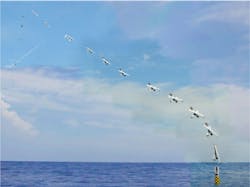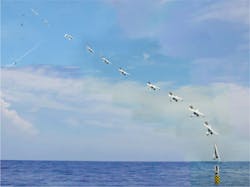U. S. Navy sub launches drone while underwater
The Navy recently launched an all-electric, hydrogen-fuel-cell-powered UAV from a submerged submarine, opening the way for submarines to expand their surveillance capabilities and include land-based targets. The UAV, an XFC, was folded and packed inside a Sea Robin launcher, which fits in an otherwise empty Tomahawk launch canister, a subsystem submarine sailors are familiar with. The Sea Robin was fired from a torpedo tube onboard the USS Providence, then surfaced, where it appeared as a spar buoy. The XFC then left the canister, deployed its X-wings and flew for several hours, beaming live video back to the USS Providence. It landed at a Navy base in the Bahamas. The drone can fly for up to 6 hr and generate enough electricity to keep it flying and power payloads.

